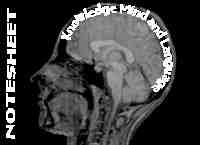Syntax and semantics
The syntax-semantics distinction
An analogy: the distinction between syntax and semantics is like the
distinction between a train of wagons and what's in the wagons.
Grammar
How are we to think of the syntax of a language?
In traditional 'grammar' there were different categories of words,
and rules which said how these might be combined if a properly grammatical
sentence was to be arrived at.
Uninterpreted symbols
What is there in language that corresponds to the empty wagon?
'Uninterpreted symbol': a language element which has not got any meaning.
A simple formal language:-
Symbols:
‡
µ
¥
Rules:
To form a properly grammatical sentence in this language:
- There must be a ‡
- There must be either µ or ¥ before the ‡
- There must be either µ or ¥ after the ‡
This permits just two grammatical sentences:µ ‡ ¥ and
¥ ‡ µ
Logical calculi
Now think of adding a third feature, besides symbols and rules for
sequencing them: derivation rules
Think of a rule which says: if you have got sequence A then add sequence
B.
Eg if you've got µ ‡ ¥ then add ¥ ‡ µ
A calculus: a set of uninterpreted symbols with rules which say which
further sequences you can have, given what you've already got. It's
a calculus.
And a system of this kind - uninterpreted symbols, rules that legitimize
certain sequences if certain others are already legitimized - gets intriguing
if the rules you set up copy the rules that appear to be used in real
argument, or real sums. Then you have got a formalisation of argument
- logic - or a normalization of calculation - mathematics.
In a logical calculus there are simply:
1. Rules for determining what counts as an expression in the system
2. What sequences of expressions count as well-formed (well-formed
formulae or wffs).
3. Which sequences of expressions count as proofs.
TWO SENSES OF SYMBOL
1. A something that stands for something.
2. A mark that belongs to a set marks, and a set of rules, such that
the rules determine how the marks may be combined.
'Grammar' in natural languages
Chomsky: if you are to get a machine to speak like we do, you will
have to get it to speak grammatically. And the way to do this is to
program into it the syntactical categories, and the rules governing
how they may legitimately be sequenced.
Semantics
If we can understand how the brain might manipulate uninterpreted symbols
according to rules, how are we to understand how those symbols might
stop being uninterpreted and carry meaning?
An approach through causality.
Here is a starting idea: a 'symbol', if we are thinking of a mechanical
brain, is something electronic, a pattern of electrical activity in
a set of neurons. Suppose it was always stimulated by a particular type
of thing in the environment. Wouldn't that give it meaning? If
a particular pattern of electrical activity in the brain was always
triggered by your seeing a badger, wouldn't that confer the meaning
'badger' on the pattern?
END
Revised 19:01:03
|